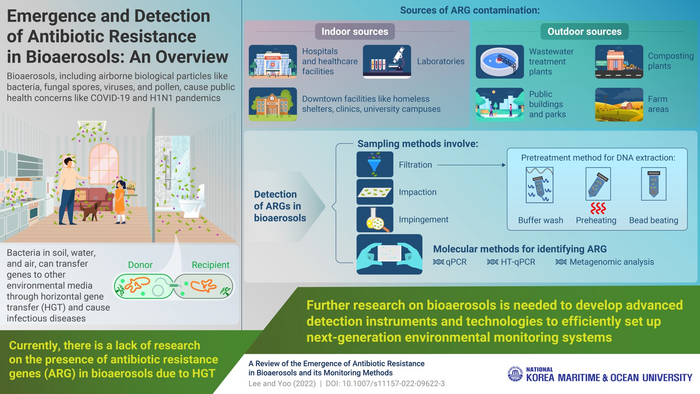Bioaerosols, or airborne biological particles containing viruses, fungal spores, bacteria, and pollen, play a key role in public health. Antibiotic resistance (AR), caused by antibiotic resistance genes (ARGs), could potentially cause global public health crises owing to horizontal gene transfer between same or similar bacterial bioaerosols. AR in microbes in soil and water environments have been extensively studied using latest molecular and biotechnological methods; however, studies investigating antibiotic-resistant bioaerosols in aerial ecosystems are limited. The key problem in studying AR in bioaerosols is the difficulty in obtaining sufficient quantities of bioaerosols for analyses.

Credit: National Korea Maritime & Ocean University
Bioaerosols, or airborne biological particles containing viruses, fungal spores, bacteria, and pollen, play a key role in public health. Antibiotic resistance (AR), caused by antibiotic resistance genes (ARGs), could potentially cause global public health crises owing to horizontal gene transfer between same or similar bacterial bioaerosols. AR in microbes in soil and water environments have been extensively studied using latest molecular and biotechnological methods; however, studies investigating antibiotic-resistant bioaerosols in aerial ecosystems are limited. The key problem in studying AR in bioaerosols is the difficulty in obtaining sufficient quantities of bioaerosols for analyses.
To shed more light, Assistant Professor Dr. Keunje Yoo and his colleague at Korea Maritime and Ocean University have collated existing knowledge on ARG in bioaerosols in a comprehensive review published in Reviews in Environmental Science and Bio/Technology. Explaining the motivation behind this article, Dr. Yoo explains, “We wanted to understand the driving force behind ARG in bioaerosols. We extensively reviewed data on the potential risk factors associated with AR in bioaerosols, their impact on human health, appropriate methodologies, and the latest technologies and advances in bioaerosol monitoring.”
So, what did they learn? Antibiotic-resistant bioaerosols are produced from several sources, categorized into either indoor or outdoor environments. Indoor environments include hospitals, healthcare facilities, laboratory buildings, and downtown facilities like offices, markets, universities, and kindergartens. The best way to detect these bioaerosols is through impaction, impingement, and filtration. Molecular and biotechnological methods including quantitative real time PCR (qPCR), high throughput qPCR, and high throughput sequencing techniques are also employed to evaluate the prevalence and levels of ARG in samples.
The World Health Organization has announced that the spread of AR is among the top ten global public health concerns facing humanity. It becomes essential to analyze the relationship between human, animal, and environmental microbiomes to counter the spread of AR. Dr. Yoo concludes, “By identifying which bacteria generate and transfer AR and by understanding the interaction between host cells, environment, tissues, and pathogens at a molecular level, we move a step closer to finding targets in managing AR in the environment.”
***
Reference
DOI: https://doi.org/10.1007/s11157-022-09622-3
Authors: Gihan Lee1,2 and Keunje Yoo1
Affiliations:
1 Department of Environmental Engineering, Korea Maritime and Ocean University, Busan 49112, South Korea
2 Interdisciplinary Major of Ocean Renewable Energy Engineering, Korea Maritime and Ocean University, Busan 49112, South Korea
About National Korea Maritime & Ocean University
South Korea’s most prestigious university for maritime studies, transportation science and engineering, the National Korea Maritime & Ocean University is located on an island in Busan. The university was established in 1945 and since then has merged with other universities to currently being the only post-secondary institution that specializes in maritime sciences and engineering. It has four colleges that offer both undergraduate and graduate courses.
Website: http://www.kmou.ac.kr/english/main.do
About the author
Dr. Keunje Yoo is an Assistant Professor of Department of Environmental Engineering at Korea Maritime and Ocean University, South Korea. His group is developing approaches to understand environmental microbiome and microbial ecology using meta-omics and data mining. Dr. Keunje’s group is also developing techniques for the identification of microbial hazard and microbial risk assessment using molecular biotechnology and bioinformatics. Before joining Korea Maritime and Ocean University, he completed the Postdoctoral training at Kartik Chandran and Ian Lipkin at Columbia University and Centre for infection and immunity at Columbia University. In 2015, Keunje Yoo received a PhD in Civil and Environmental Engineering from Yonsei University, South Korea
Journal
Reviews in Environmental Science and Bio/Technology
DOI
10.1007/s11157-022-09622-3
Method of Research
Literature review
Subject of Research
Not applicable
Article Title
A review of the emergence of antibiotic resistance in bioaerosols and its monitoring methods
Article Publication Date
6-Jun-2022
COI Statement
The authors declare no competing financial interests




